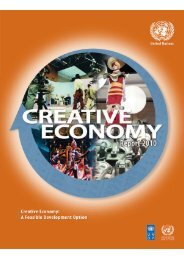Model curricula for journalism education for developing countries ...
Model curricula for journalism education for developing countries ...
Model curricula for journalism education for developing countries ...
Create successful ePaper yourself
Turn your PDF publications into a flip-book with our unique Google optimized e-Paper software.
23<br />
wars, massacres, violence. The course will pay special attention to sensitivity and<br />
safety issues in reporting on conflict.<br />
Media and society<br />
Critical analysis of the role the media play in the architecture of democracy and the<br />
effect of political, economic, cultural, and technological factors on the operation of<br />
the media. The course will include national and international issues of censorship<br />
and government control, media and conflict (including civil militancy and violence,<br />
and peace initiatives), the organization and ownership of media, the value of media<br />
diversity and pluralism, gender, ethnic, religious and racial sensitivity, issues of<br />
social class, poverty, development, and public health, the impact of technological<br />
change, advertising, and trends such as celebrity <strong>journalism</strong> and “infotainment”,<br />
the media’s role as critic, the effect of news coverage on the public, and the ways in<br />
which governments exercise power and communicate through the media. national<br />
and international and an introduction to different journalistic cultures and practices.<br />
Newspaper workshop<br />
In this workshop, students produce a weekly newspaper from start to finish — from<br />
generating story ideas to producing the pages to the final stage be<strong>for</strong>e printing.<br />
The workshop there<strong>for</strong>e includes instruction and practice in newspaper reporting,<br />
writing, editing, page design, and online page production. Students will be introduced<br />
to the skills that news editors (or assignment editors) — as well as reporters — use<br />
to generate assignments, and the skills copy editors (or sub-editors) use to select<br />
and handle stories and pictures. They will learn to edit <strong>for</strong> tightness, accuracy and<br />
style, to see the story as a whole and line by line. They will learn to design and<br />
produce pages, including selecting and using stories and pictures, and writing<br />
captions, headlines, sub-heads, etc. By the end of the workshop they should be<br />
prepared to work as page editors on newspapers. In this workshop, or as a separate<br />
workshop, students will receive instruction in the principles and practices of<br />
photo<strong>journalism</strong>, photographing news, features, portraits, and sports, and designing<br />
and producing picture layouts using digital techniques.<br />
Broadcast workshop<br />
Students will develop story ideas, assign stories, write, edit, line up and per<strong>for</strong>m<br />
newscasts, host, do tape talks, prepare mini-documentaries, and conduct studio and<br />
field interviews. By the end of the workshop they will have the knowledge and skills<br />
to produce a news report or interview that meets professional standards and should<br />
be ready to begin work on the editing or production staff of a radio or television news<br />
program.

















